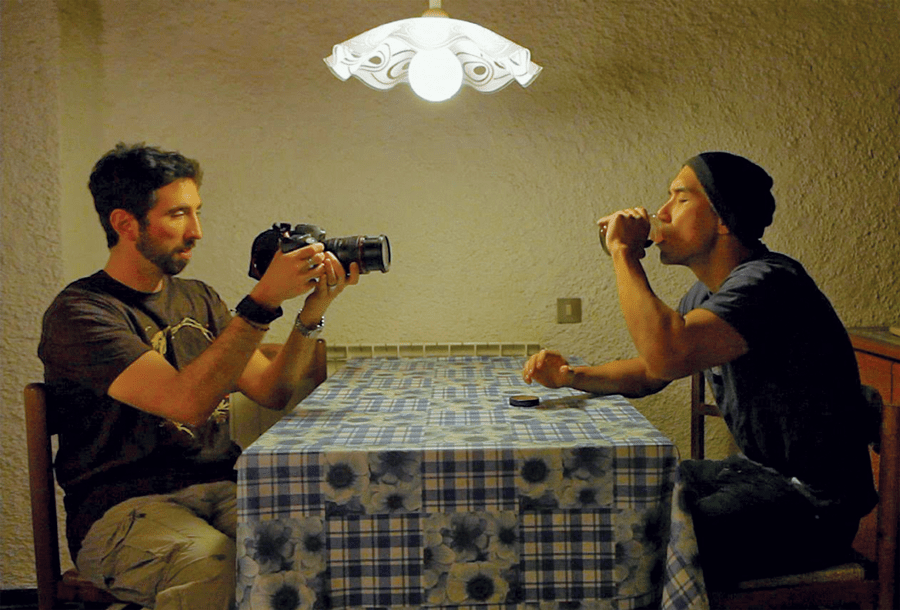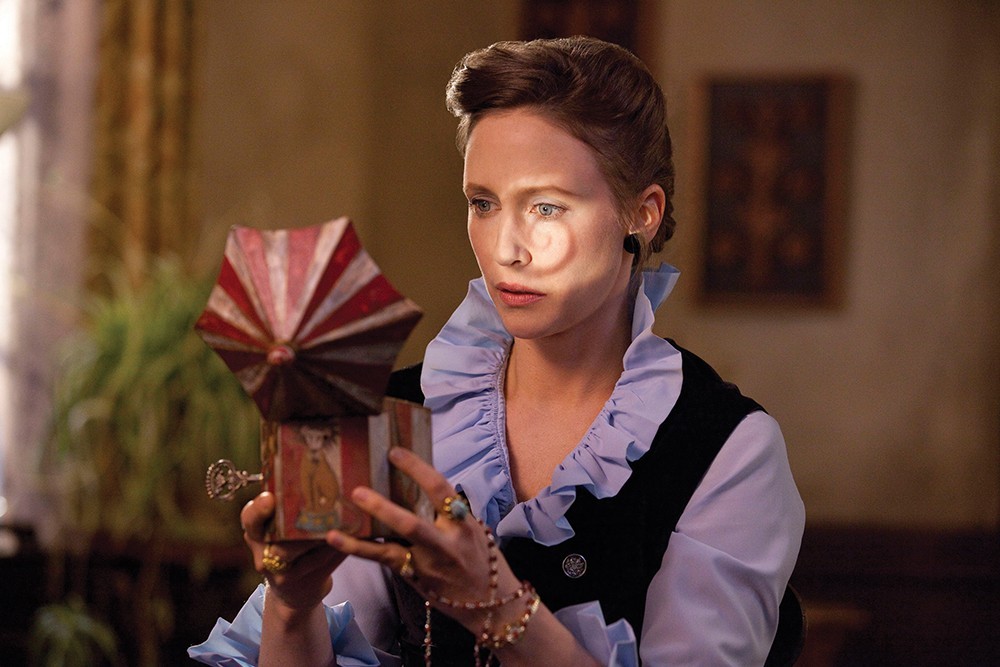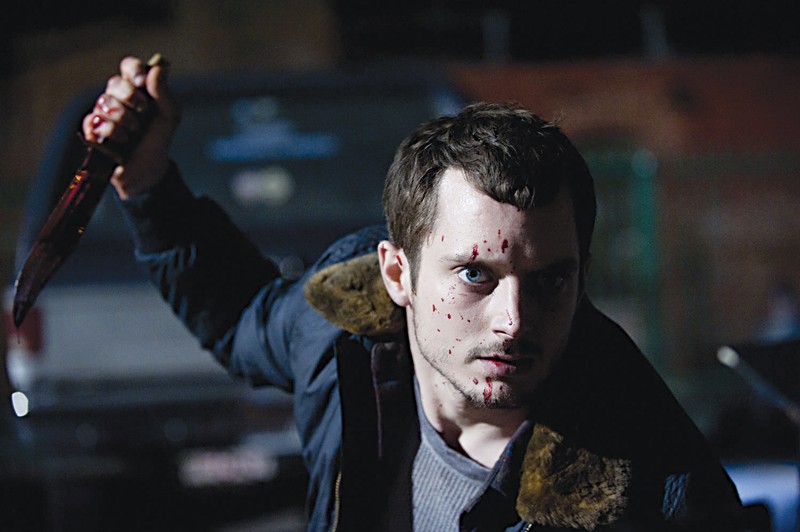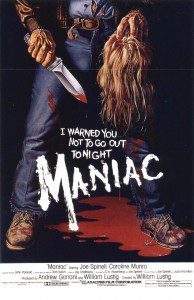The voices. I need to get them out. Just make them go away. The voices. They drive me insane. Always talking, talking, talking. They make me SCREAM!
Continue readingIt Follows — Film Review
Noel: Early in the film, Jay (Maika Monroe) asks Hugh/Jeff (Jake Weary) to pick a random stranger with whom he wouldn’t mind switching lives. Curiously enough he chooses a little boy because he envies his ‘total freedom’, going ‘to the bathroom any time [he wants]’ and ‘get[ting] away with that’.
It’s telling that, out of all possibilities, Hugh/Jeff goes for toilet duties. Apparently he yearns for a regressive state in which his ego is not yet fully formed, one in which he is fully dependent on an outside agency. It’s a strange thing coming from a young man on the cusp of adulthood. However this is a theme that runs through the entire film: a sort of coming of age tale in reverse.
The protagonists in It Follows seem to be battling against the relentless passage of time. They are doing things that grown-ups do, including sex; yet they still want to be like that little boy and shed responsibility. By doing so they subvert one of the main tropes of the slasher film, a sub genre which It Follows certainly endorses: sex as a rite of passage from childhood into adulthood.
Jay repeatedly uses the house pool. With our Freudian hats on, the pool becomes an obvious reference to her trying to reclaiming the security of her mother’s womb. It’s her comfort zone and she goes there to be on her own, to feel safe. We never see her share the pool with anyone else.
It is revealing though that when Jay (supposedly) has sex with three men in a boat, she goes back to the pool only to find it broken and empty of water. This suggests that her indiscriminate choice of sexual partners has robbed her of a substantial amount of that yearned for ‘childhood innocence’. She has crossed the point of no return, another manifestation of which is the murderous spectre that is ruthlessly following her.
“The nuclear family has jumped ship. There is nobody to whom the young generation can turn to for advice and they are left to cope on their own.”
The adult world is conspicuously absent. We rarely come across grown-ups and when we do they seem to inhabit a different world. Take when Jay enters the living room garbed in a towel, as her sister and her friends are watching tv. Their mother is at the back of the shot, totally immersed in her glass of wine and phone conversation, visually cut off by a wooden beam and separate lighting. It happens again when Jay is talking to a policeman. The camera is placed very low, giving us a child’s point of view, and the officer is nothing but a disembodied bit of trouser leg.
The nuclear family has jumped ship. There is nobody to whom the young generation can turn to for advice and they are left to cope on their own. It Follows is an anti-coming of age tale because there is no conflict between the young and the old, and without conflict there is no growth.
Krista: It Follows has received widespread recognition making ripples outside the niche/cult horror community. Film critic Mark Kermode commented on its ‘art-house’ distance from genre conventions. Horror films that challenge boundaries are hardly rare; however, few receive such wide recognition. The reasons are rooted in how certain film genres are viewed, which is problematic. This leads to the elevation of films that seemingly transcend genre.
It Follows has won recognition, while embracing its genre-allegiance.
Its quasi-climactic pool scene is reminiscent of the finale in Cronenberg’sShivers (1975). Both films feature a kind of infectious sexual awakening. However, where Shivers is celebratory, orgiastically joyful, the sex in It Follows feels oddly uneventful. Though the climax takes place in a communal pool, it follows the pattern established in the previous house pool scenes—Jay is isolated within the larger pool.
The film’s use of space reinforces this impression of isolation. Though in the vein of coming-of-age movies, the film foregrounds friendship, there is a sense of extended silence, isolation—a space of waiting, never fully breached. As the teacher reads TS Eliot’sThe Love Song of J. Alfred Prufrock, Jay sits at the far end of a long table on her own. This is reinforced in scenes showing expanses of sea and sand and grey, with a slow walking ‘it’ that follows Jay. The slowness of this sinister presence that permeates the film is reminiscent of Hancock’sLet’s Scare Jessica to Death (1971) and Blatty’sExorcist III: Legion (1990).
There is anticipation, but as Noel notes, there is no corresponding growth. The film lacks a climax – dread settles, quietly. On the way to the pool, Yara (Olivia Luccardi), one of Jay’s friends reminisces: ‘when I was a little girl, my parents wouldn’t allow me to go south of 8 Mile. And I didn’t even know what that meant, until I got a little older, and I started realising that that’s where the city started, and the suburbs ended.’ The film positions itself in a moment of suspension, never leaving the suburbs, calling: ‘there will be time, there will be time…’ But time for what?
WYRMWOOD
Afflicted — Film Review

Noel: I was surprised to see that Afflicted was a vampire movie. From the trailer I gathered that it was going to be a contagion film. Vampires and pestilence share a common history but I was thinking 28 Days Later (2002) rather than The Addiction (1995). Unfortunately, despite finding it entertaining, it hardly broke any new ground in terms of vampire lore. Apart from its use of shaky-cam film-making, we’ve seen it all before.
Krista: Speaking of vampire lore—one highlight for me was the ill-fitting conversation referencing ‘traditional’ vampire lore (‘Well you should have the ability to turn into mist.’) which contrasted with that attempted ‘realist’ style. I’m actually impressed that they didn’t fall into the usual US stereotyping and made it happen in some ‘mysterious’ backwoods of ‘Old Europe’, but chose Paris as a hub of civilisation.
N: However the filmmakers still kept the vampire at arms’ length, making the monster foreign. As you pointed out, it’s not Transylvania or the Yorkshire moors; but it’s still an American who got infected by a European.
K: I also liked that despite their attempt to be innovative, they weren’t pretentious and even included traditional jump scares. I liked the first-person perspective (fpp) during the run—kind of game-like.
N: His heightened perception and supra-human powers reminded me of Chronicle (2012). It was fun but I wouldn’t want to watch it again.
K: The film spends a while setting up the friendship, so I’m not sure why it was ended early. It was a brave move and foregrounded isolation but the ending fell flat for me. I was disappointed with the half-hearted fight sequence and the cringe-worthy moralising and sentimentalising. That vigilantism could be an interesting parody and critique of institutionalised ‘justice’, seen in many ‘revenge films’. But here it just brought it back in line with conservative morality.
N: The moralising was a shaky-cam version of Louis in Interview with the Vampire (1995). Even if we had to isolate Derek’s crisis (the main character) and take it for what it was, it’s still not that interesting. It reminded me of a bad Pepsi Max advert, highlighting thrills and shallow been-there-done-that moments. On another note: what do you think about the found footage? Is it overstaying its welcome? I think so. I’m finding it tedious and boring for an entire feature-length film. Get a tripod!
K: I’m surprised that found footage has outlived its ‘novelty’ factor. I was kind of sceptical about that but several films, including V/H/S (2012), have convinced me there’s still life in it. I have three main reasons: (1) its DIY possibilities, which gives a new lease to indie directors without the backing of glossy production; (2) its proximity to some fpp video games—disorientation, chase; (3) it seems to be associated with the horror genre. Other genres borrow it as a device; horror embraces it. I’m not sure why exactly but ‘found text’ is found in horror literature, from Bram Stoker to Mark Z Danielewski, it’s an established device.
N: So, final verdict? I recommend Afflicted if you’re looking for an hour and a half of harmless entertainment. A camp-fire story for the tech-savvy generation.
K: Perhaps more of a ‘teen adult’ horror; it references a horror tradition, but doesn’t add much that’s new, perhaps more rewarding for less ‘seasoned’ horror fans.
You’re Next — Film Review

A home-invasion movie with the possible tag-line ‘they got more than they bargained for’. No, it’s not Home Alone — though you may be forgiven for thinking that.
From part of the team that gave us V/H/S, You’re Next bears Adam Wingard’s trademark playful-violent stamp (think Home Alone’s cartoonish violence, with lethal contraptions thrown in). Wingard makes an appearance in both V/H/S and as himself in his segment for The ABCs of Death (‘Q’); though he doesn’t appear in You’re Next, the latter film incorporates a characteristically self-conscious knowing wink, featuring writer Simon Barrett and fellow film-makers Ti West and Joe Swanberg in supporting roles — Ti West’s Tariq introducing himself as a ‘documentary film-maker’, with high ‘intellectual’ (and short-lived) aspirations.
Adam Wingard self-consciously plays with conventions, without quite overturning expectations. The ‘final girl’ slasher convention is here taken a little further, Sharni Vinson’s Erin is not a scream queen fleeing danger, with a dash of luck on her side, she is resourceful and an equal match for the ‘invaders’. The villains’ usual resistance to death is here transferred to a less likely character, in a ‘why won’t you hurry up and die already?’ moment that is brilliantly played up for comic effect.
Little nods to other home-invasion movies frame particular moments: such as an animal-masked figure — simultaneously disconcertingly jarring and ridiculous — sitting on a couch beside a propped-up dead body in an upper-middle class setting, for a quiet Funny Games pause in the action, with an added cartoonish element.
The generally fast-paced action is spaced out with moments of tension, and an effective balance is struck between the danger trying to penetrate into the space of the family/parents’ home, and the danger already ‘within’.
The ‘home’ itself is a newly-acquired house, territory as unfamiliar to the family and guests as it is to the uninvited invaders — not quite lived in, not quite a ‘home’ yet, just as the family-relations are themselves characterised by awkwardness. While lessening the terror that stems from the violation of a warm and safely welcoming homely space, this accentuates the unsettling absence of refuge for the characters, with vulnerable interior–exterior boundaries.
With two striking exceptions, death scenes were disappointingly standard. The premise and set-up of the movie could easily have led to more inventive devices. You’re Next is slasher, home invasion, and murder mystery, all rolled into one; yet, it remains firmly and respectfully within genre conventions. Nothing wrong with this — I’m not about to make any apologies for a genre I have so much affection for. Yet, there is a lingering sense of an opportunity missed — Wingard’s self-awareness and sense of the ridiculous gives a glimpse for greater potential here restrained.
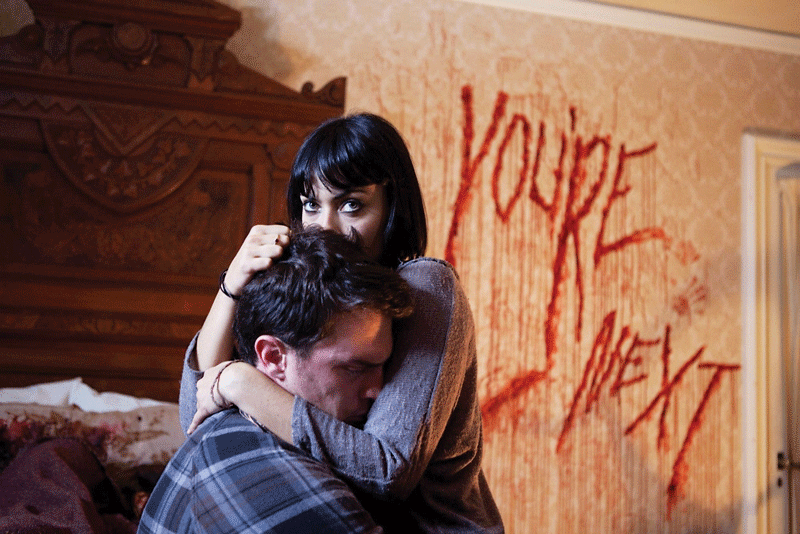
The Conjuring — Film Review

Krista: James Wan’s film is irresponsible for its appalling suggestion that the Salem witch hunt was somehow a justifiable massacre. The dead earnestness of those who ‘inspired’ it makes me shudder. The ‘true story’ malarkey is common in horror taglines but this movie seems more earnest about those credentials by basing its characters on real people.
Noel: You’ve got a point there. Even though the story revolves around female characters, most of them are either ghosts or victims. The true menace is motherhood itself. Even Annabelle the doll exploits maternal instinct to haunt its hosts. The ghost of the witch, despite being after the children, first possesses the mother then tries to make her kill the child.
K: Are you suggesting that the film distorts the maternal instinct?
N: Yes, as far as the witch’s ghost is concerned. That is why it tries to corrupt the other mothers. The males simply orbit.
K: That’s another thing: how seriously does it take itself? There’s the playfulness one associates with a Wan film, especially references to other horror movies, such as The Evil Dead (‘groovy’). Wan is a horro fan who indulges in it for its own sake.
N: I found The Conjuring very dark in tone, compared to Insidious, his previous ghost film. The geeky paranormal researchers play a less central role.
K: How does the motherhood bond in The Conjuring compare to the fatherhood bond in Insidious?
N: The fatherhood bond is tenuous there. The mother is most worried about their haunted son.
K: You are right about the mother being the emotional centre and her level of concern in Insidious. However, the problem originates from the father, who passes on the legacy of astral projection. And it’s the father who rescues the son. I thought the mother-son relationship was more peripheral. She tries to influence events but isn’t a moving force.
N: Off on a tangent: James Wan is such a good filmmaker. He’s confident and knows exactly what he wants to get across without resorting to boo! gimmickry. The scariest bits in the film happen with a static camera and no cuts. Just mise-en-scène — a visually artful way of telling a story. For example, the bedroom scene with the two sisters. One of them points at a ghost that is never seen. Since we’re watching a horror film, we know it’s there. And Wan sustains the scene long enough to get under our skin. Brilliant!
K: That’s true. Though in terms of unexpected shifts, these do occur often. Take that ‘odd’ devil scene in Insidious where it feels like a different horror subgenre. There are these shifts in tone and style in The Conjuring too, but it is more consistent than Insidious overall.
N: Insidious is simply superb up until the ‘ghostbusters’ appear; then it becomes goofy.
K: Though I’d take any Lin Shaye character over the Warrens.
N: I am with you on Wan’s playful approach. Honestly, I’d love to see a ‘mature’ James Wan film through and through. Given the right script, he would make a great film. Krista, could we say that The Conjuring is a second take at Insidious?
K: I agree with what you said when we came out of the cinema — that it refers back to his earlier film. Though I still prefer Insidious, because of those jarring shifts from subtle to unsubtle, which are tricky to pull off, but
somehow work. The Conjuring is certainly more polished, but I cannot quite see it as more ‘mature’ than Insidious, mainly because of its political irresponsibility.
Maniac: Two films. Two reviewers.

Noel: I recently saw William Lustig’s Maniac (1980) and Franck Khalfoun’s 2012 remake back-to-back. The latter is rather faithful to the original’s spirit. Frank Zito (played by Joe Spinell [1980] and Elijah Wood [2012]) is more of a textbook psychopath, and more brutal in Khalfoun’s film; but still remains faithful to its source.
Krista: I thought the first’s ‘rawness’ was more brutal. The second had a polished style despite the first person perspective. The 1980 film was grittier.
N: True. The remake looks slicker. For instance, the murder scenes are meticulously choreographed, operatic even. Lustig’s film is truer to life, scarier too, because in his lucid moments the killer acts normal.
K: The first person perspective didn’t convince me. Eventually I even forgot about it till it suddenly jumped to the fore again. It was inconsistent and uneasy without being very unsettling. It reminded me of Peeping Tom (1960), which made better use of the first person perspective.
N: Agree, but it didn’t distract me.
K: I hoped it would be more ‘distracting’. It would have been preferable if the first person perspective had been more defamiliarising, puncturing the viewer’s comfort zone — rather than just being ‘naturalised’.
N: The subjective point of view didn’t help me to get closer to the killer. I only saw this technique being used effectively in Enter the Void (2009). I find it a bit distracting because it can turn into a weird game (Spot the reflection in the mirror!). That said, in Maniac they were well aware of this and tried to have fun with it. The moments when the film veers away from the first person perspective, it sort of clicks into another gear.
K: Good point about the first person perspective being the default here, and the veering away from it becoming a ‘moment’ in itself. It calls to mind Bret Easton Ellis’ book American Psycho (1991).
N: I liked the fact that the remake created a deeper relationship between Frank and the mannequins. They are more than just a manifestation of his childhood trauma — a dysfunctional, promiscuous mother. The restoration of the mannequins is a genuine labour of love which underscores the affection that he nurtures towards the photographer (Anna, played by Nora Arnezeder). She is a mediocre artist unable to hold her camera properly. Frank is the real deal, getting his hands dirty.

K: That’s a well-noted criticism of the photographer. In the first movie, I couldn’t really ‘judge’ whether she was a good artist or not — there wasn’t a focus on her art, instead they showed the world she moves around in, which made me think she was a budding artist. In the second one she’s portrayed as an underwhelming artist. She tries to use the mannequins to underpin her art and to somehow appropriate his by projecting an image of her face onto their blank heads.
N: Besides Anna, two other victims in Khalfoun’s film are a dancer and an agent. In both murders the director abandons the first person perspective, suggesting that either Frank is seeing his actions as a form of art, or that we, the audience, should see Frank himself as a work of art.
K: Yes, perhaps even perverting the sublime into the brutally grotesque. Yet ‘getting his hands dirty’ is counterpoised by the film’s stylishness.
N: So which is better?
K: Both films ultimately do different things. This is down to stylistic differences, enjoyably the remake doesn’t try to ‘replace’ Lustig’s film.
N: Totally agree. They’re like brothers sharing one (hell of a disturbed)
mother, similar yet so different. •
https://www.youtube.com/watch?v=4umIfrP_vMk



